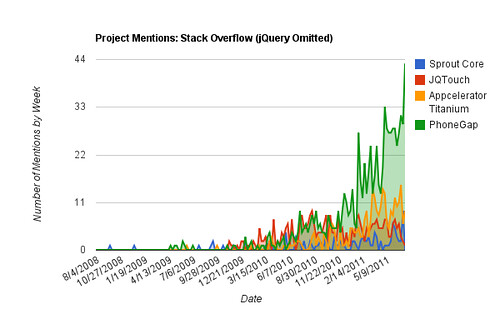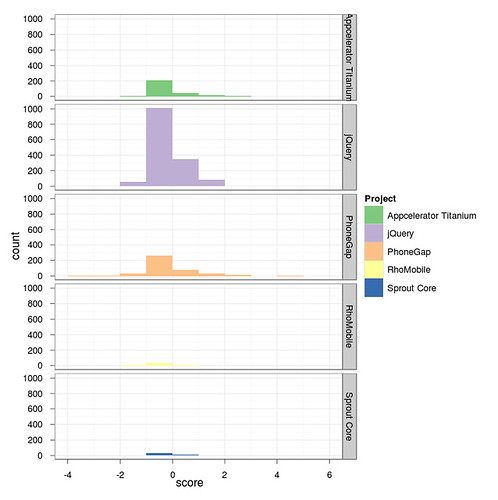On behalf of one of our clients, we’ve been doing some number crunching on the mobile market in recent weeks. One byproduct of that research was confirmation of a rise in interest in PhoneGap.
PhoneGap itself has observed the same. These recently posted slides indicate massive growth in web traffic, both onsite and at GitHub, accelerating mailing list traffic and a spike in application creation.
Our data indicates similar interest and traction.
First, we explored the relative traction rates on StackOverflow of projects associated with mobile.

As you can see, PhoneGap is outpacing other mobile projects from a mentions perspective within the Stack Overflow community. But what about Hacker News?

As you can see, the data is similar. PhoneGap interest and traction is accelerating.
We also performed a rudimentary sentiment analysis on the various projects using Twitter’s standard API.

Before we get into the results: this is a small, non-random sample, so it cannot be considered representative. It’s useful for informational purposes only. With that said, PhoneGap’s relatively positive performance here is unsurprising given their increased adoption.
What you’re looking for in this chart is skew: are the bars higher on the left (negative comments) or right (positive comments)? And how far do they go, which is a different way of asking, when people said good or bad things, how many good or bad words did they use?
As you can see here, PhoneGap is positively skewed, and had the most positive tweets (those with a net of 5) of any project included.
When you consider the metrics, then, and the fact that PhoneGap is aimed at a problem in mobile platform fragmentation that is getting worse by the day, it’s clear that it’s a project worth tracking.
Disclosure: PhoneGap is a RedMonk customer.

Kevin Griffin says:
August 6, 2011 at 6:07 pm
I first wrote about PhoneGap back in March of last year, and I’ve seen the community grow steadily since then.
The community is one thing that sets PhoneGap apart from others in the space, from the wiki to google groups to meet ups to IRC to GitHub it’s accessible to everyone 🙂
I can’t help but think the community is part of the ‘Rise of PhoneGap’ – oh and the fact it’s awesome… and under the Apache License.
Scott Schwarzhoff says:
August 10, 2011 at 11:35 am
First off, let me say that we love Phonegap. It, along with our product Appcelerator Titanium and others, validates that the open web model for building cross-platform applications is here to stay and is a very viable path for developers and businesses. Second, congrats to the Phonegap team for hitting 1.0. Tons of work from talented developers went into reaching that milestone.
Not taking anything away from Phonegap, but the comparisons made above to Appcelerator Titanium are misleading at best. Here’s why:
– We have tremendous equity in two brands, Appcelerator and Titanium. Do a search on Titanium. You’ll see our site comes in higher than the metal itself. Next, head over to Alexa, look at Appcelerator.com, click on search analytics. You’ll see just how important the standalone Titanium keyword is to overall traffic. I’m providing this as external validation of our own internal google analytics. So, any chart above that just searches on Appcelerator is underrepresented by at least half, and most likely more.
– Here are our key stats, which basically tells the net story:
o On site traffic: we had 600,000 visitors last month and 2.5M pageviews. You can externally validate our traffic through alexa or compete.
o We power 25,000 apps today. We powered 8,000 apps at the beginning of the year. We know this because we have analytics in all our apps. That’s more than all other platforms besides Apple and Google. Note: don’t confuse apps created with apps shipped. We’ve had over 500,000 apps started in Titanium.
o Of our total 1.5M developers (thanks to the Aptana acquisition), 185K are registered mobile developers. These developers have downloaded Titanium updates at least 4 times, putting our “download” total around 740K. BTW: my understanding is that the Phonegap mailing list is between 10-20K. Difference in approach.
At the end of the day, the two approaches share a common link: web developers building mobile applications across multiple platforms. But our directions are very different. The Phonegap approach is to wrap a website and extend with device capabilities. This requires about 30 methods (source: http://docs.phonegap.com/index.html) to extend webkit’s functionality as an app.
Our approach is very different. Instead of a framework approach, we have, in essence, built a cross-platform operating system. There are 915 methods in our API (source: http://developer.appcelerator.com/apidoc/mobile/latest). This is what we mean by native. *Everything* is native.
Phonegap sure is rising, and that’s great for web developers. But to imply directly or indirectly that we are not ‘rising’ as fast or even faster is misleading. At the end of the day, there are two distinct choices that web developers can make. Our advice is to try out both approaches and decide which is best for your business.
Scott Schwarzhoff
VP, Marketing and Developer Relations
Appcelerator, Inc.
JavaScript Magazine Blog for JSMag » Blog Archive » News roundup: png.js, pouchDB, finding memory leaks in JavaScript, Page Visibility API says:
August 12, 2011 at 3:42 pm
[…] (August 11, 2011) (slides) Mobile WebKit Optimizations & Tools (Glan Thomas and Andrew Hedges) (slides) The Rise of PhoneGap (video) Nodester: Create & Deploy a Node.JS App in Less than 2 […]
On Adobe’s recent repositioning says:
December 8, 2011 at 10:13 pm
[…] In related news Adobe is also dropping mobile Flash, in favour of packaging HTML5 and native for mobile and tablet apps using PhoneGap (also now an Apache proposal). PhoneGap definitely has significant market momentum. […]